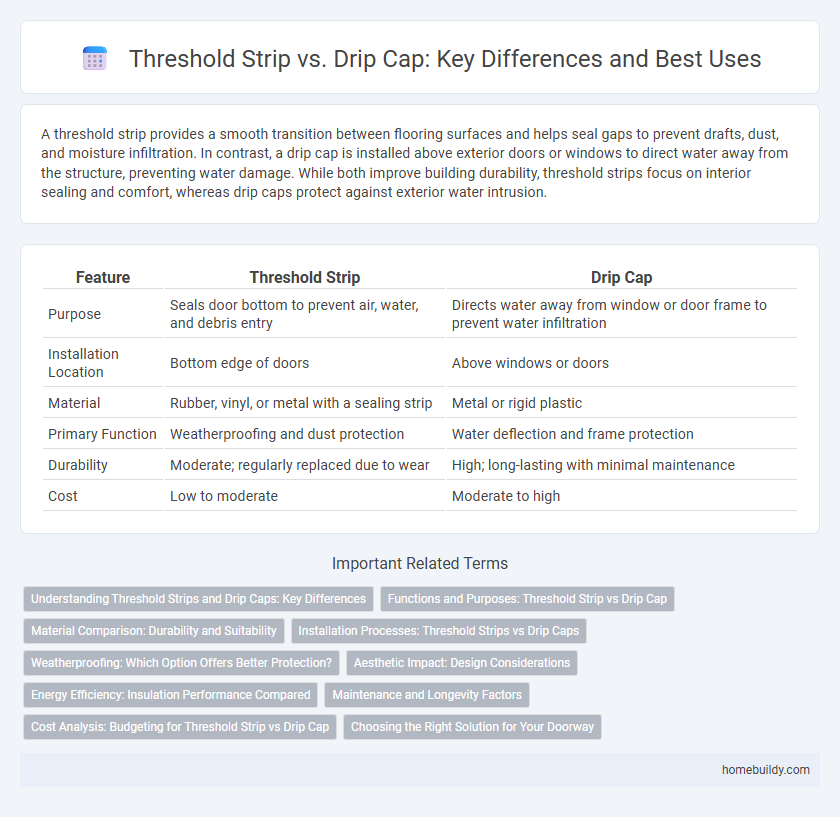A threshold strip provides a smooth transition between flooring surfaces and helps seal gaps to prevent drafts, dust, and moisture infiltration. In contrast, a drip cap is installed above exterior doors or windows to direct water away from the structure, preventing water damage. While both improve building durability, threshold strips focus on interior sealing and comfort, whereas drip caps protect against exterior water intrusion.
Table of Comparison
| Feature | Threshold Strip | Drip Cap |
|---|---|---|
| Purpose | Seals door bottom to prevent air, water, and debris entry | Directs water away from window or door frame to prevent water infiltration |
| Installation Location | Bottom edge of doors | Above windows or doors |
| Material | Rubber, vinyl, or metal with a sealing strip | Metal or rigid plastic |
| Primary Function | Weatherproofing and dust protection | Water deflection and frame protection |
| Durability | Moderate; regularly replaced due to wear | High; long-lasting with minimal maintenance |
| Cost | Low to moderate | Moderate to high |
Understanding Threshold Strips and Drip Caps: Key Differences
Threshold strips provide a sealing barrier at door bottoms to prevent drafts, moisture, and pests, enhancing energy efficiency and indoor comfort. Drip caps are installed above windows and doors to divert rainwater away from the structure, protecting the framing from water damage and rot. Unlike drip caps that primarily manage water flow, threshold strips focus on sealing and insulation at entry points.
Functions and Purposes: Threshold Strip vs Drip Cap
Threshold strips provide a seal at door bottoms to prevent drafts, water, dust, and insects from entering, enhancing energy efficiency and indoor comfort. Drip caps are installed above doors or windows to divert water away from the frame, protecting against water infiltration and structural damage. Both components work together to improve weather resistance, but threshold strips primarily seal gaps at the base, while drip caps focus on water management at the top.
Material Comparison: Durability and Suitability
Threshold strips are typically made from aluminum, rubber, or vinyl, offering strong resistance to wear, moisture, and temperature fluctuations, making them highly durable for door entry points. Drip caps are usually constructed from metal such as aluminum or galvanized steel, designed primarily to deflect water away from windows and doors, prioritizing durability against weather elements rather than foot traffic. Material selection for threshold strips emphasizes impact resistance and flexibility, while drip caps focus on corrosion resistance and water-shedding capabilities, determining their suitability based on their intended function.
Installation Processes: Threshold Strips vs Drip Caps
Threshold strips install by securing a metal or rubber strip along door bottoms to seal gaps, requiring precise measurement and screwing or adhesive application for effective weatherproofing. Drip caps involve mounting a metal or vinyl flashing above windows or doors, angled to divert water away, requiring caulking and fastening to ensure water resistance. Installation of threshold strips primarily focuses on creating airtight seals beneath doors, whereas drip caps emphasize directing moisture away from structural openings.
Weatherproofing: Which Option Offers Better Protection?
Threshold strips create a tight seal at door bottoms to prevent water, air, and debris infiltration, enhancing weatherproofing effectively. Drip caps redirect water away from door frames but do not provide a complete barrier against drafts or moisture seepage. For superior weatherproofing, threshold strips offer better protection by sealing gaps and reducing potential water damage.
Aesthetic Impact: Design Considerations
Threshold strips offer a sleek, low-profile finish that seamlessly integrates with flooring, enhancing the doorway's overall aesthetic without drawing attention. Drip caps, by contrast, provide a more pronounced visual element above door frames, often emphasizing function over subtle design. Selecting between threshold strips and drip caps depends on the desired aesthetic impact, with threshold strips better suited for minimalist, modern interiors.
Energy Efficiency: Insulation Performance Compared
Threshold strips provide superior energy efficiency by creating a tighter seal at door bottoms, effectively reducing air infiltration and heat loss compared to drip caps. Unlike drip caps, which primarily divert water away from door frames, threshold strips are specifically designed to enhance insulation performance and maintain indoor temperature stability. This results in lower heating and cooling costs and improved overall energy conservation in buildings.
Maintenance and Longevity Factors
Threshold strips require less frequent maintenance than drip caps due to their simple design and resistance to wear from foot traffic and weather exposure. Drip caps, often made of metal or vinyl, can corrode or warp over time, necessitating periodic inspection and replacement to maintain their water diversion effectiveness. The longevity of threshold strips typically exceeds that of drip caps when installed correctly with durable materials, offering enhanced protection against moisture and drafts.
Cost Analysis: Budgeting for Threshold Strip vs Drip Cap
Threshold strips generally present a more cost-effective option compared to drip caps, with prices typically ranging from $10 to $50 per linear foot depending on material and finish. Drip caps, often made from higher-grade metals or custom materials, can cost between $30 and $100 per linear foot, increasing installation expenses due to additional labor requirements. Budgeting for threshold strips allows for significant savings, especially in projects prioritizing functional sealing over complex water diversion provided by drip caps.
Choosing the Right Solution for Your Doorway
Threshold strips provide a durable seal against drafts, moisture, and dirt at the base of a doorway, enhancing energy efficiency and comfort. Drip caps are installed above doors to divert rainwater away, preventing water intrusion and damage to the door frame. Selecting the right solution depends on whether your priority is weatherproofing the door bottom or protecting the top from water exposure, ensuring optimal doorway performance and longevity.
Threshold strip vs Drip cap Infographic

 homebuildy.com
homebuildy.com